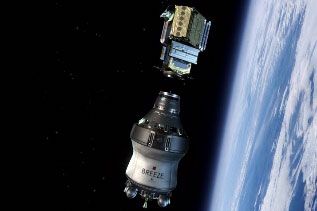Europe launches pair of new satellites
One satellite will monitor climate change, while the other is testing a series of new technologies.

The European Space Agency (ESA) successfully launched a pair of climate change monitoring satellite into orbit over the weekend.
The Soil Moisture and Ocean Salinity (SMOS) satellite launched from the Plesestk Cosmodrome in northern Russia last night. The 685kg satellite, built by Thales Alenia Space, carries a Microwave Imaging Radiometer using Aperture Synthesis (MIRAS), which uses 69 sensors on three arms to measure the temperature of the earth to test for water salinity and soil moisture.
"The data collected by SMOS will complement measurements already performed on the ground and at sea to monitor water exchanges on a global scale," said Volker Liebig, ESA's Director of Earth Observation Programmes in a statement. "Since these exchanges most of which occur in remote areas directly affect the weather, they are of paramount importance to meteorologists."
That larger satellite also carried up a second demonstration satellite called Proba 2, which will test 17 new technologies.
The 135kg satellite carries fibre sensors, a camera with a wide angle view of 120 degrees, a dual frequency GPS space reciever, a cold gas generator, tools to study the sun and something called a "xenon-fed resistojet thruster".

The SMOS satellite is in orbit 760km above earth, with Proba 2 just below it at 725km. The testing is being controlled by labs in France and Belgium, but it will be two months before Proba 2 starts sending back data, and longer for SMOS to be fully operational, ESA said.
"We are extremely pleased with this double lucky strike' that will provide Europe with new tools to better understand our planet and climate change, as well as new technology breakthroughs that will enhance the competitiveness of European industry on the world-wide market, thus contributing to the global economy," said Jean-Jacques Dordain, ESA's Director General, in a statement.
Get the ITPro. daily newsletter
Receive our latest news, industry updates, featured resources and more. Sign up today to receive our FREE report on AI cyber crime & security - newly updated for 2024.
Click here to read about 40 years of space technology.




